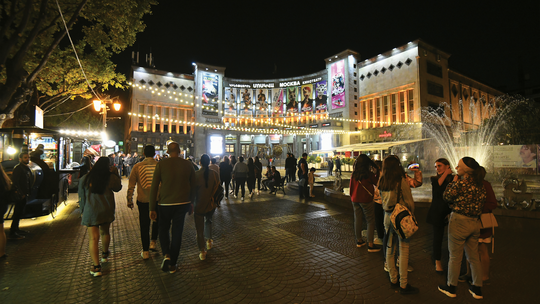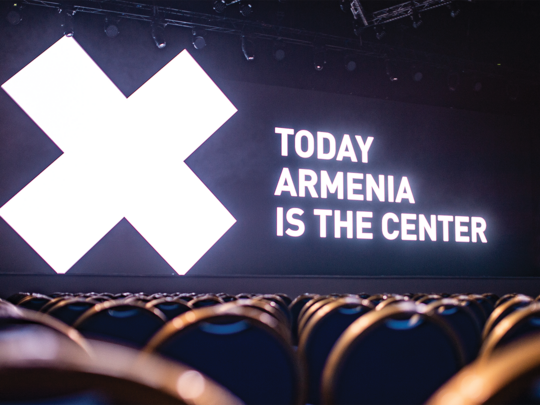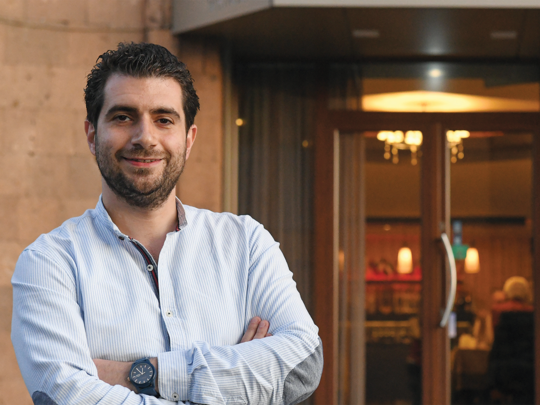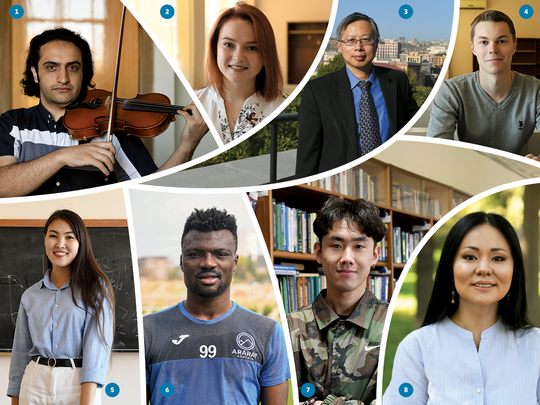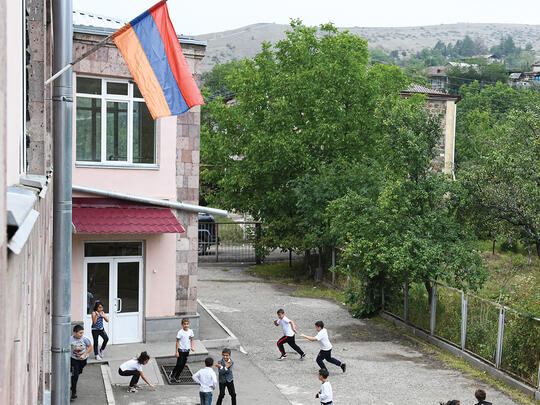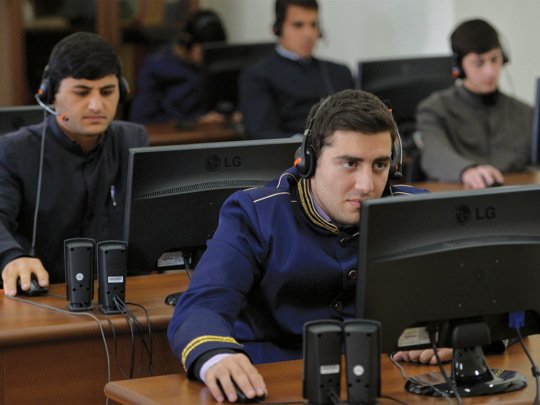To some, the Armenian film industry is still a myth. In the century since its birth, it has documented the plight of a people, celebrated narratives across republics, and served as a vital political tool. In the consecutive tragedies that shepherded Armenia through its independence, the Armenian film industry, and film culture, all but died.
However, as 2020 approaches, the role film plays in Armenia’s society is being restructured, redefined and reimagined. At the intersection of business, technology, education and art, film reflects more than popular culture and societal shifts in a country, its production also belies a nation’s economy and governance. In Armenia today, passionate professionals from all spheres of the film industry are working to diversify themes, improve media literacy and reanimate this notoriously mercurial business.
Armenian Film’s Golden Age
Though the first explicitly Armenian film, Haykakan Cinema, was produced by Armenian-Egyptian Vahan Zartarian in 1912 in Cairo, the birth of the Armenian film industry coincided with the 1923 establishment of the Soviet production company that would come to be known as Armenfilm, or Hayfilm.
“You must remember always,” proclaimed Vladimir Lenin, “that of all the arts, the most important for us is the cinema.”
Moving image, at that time still silent, made literacy obsolete in communicating big ideas, like revolution. Once beguiled, the people would believe, would be emboldened to act. Understanding that film was uniquely potent when it came to nation-building, Bolshevik leadership invested heavily in establishing production companies throughout the newly unified Soviet republics.
In the seven decades Armenia was part of the Soviet Union, Armenfilm was notably illustrious. Three of the most renowned filmmakers from the USSR—Hamo Beknazarian, Artavazd Peleshyan and Sergei Parajanov—were Armenians, navigating this state-run production company while creating masterpieces revered for their visionary film language internationally. “Soviet cinema was a big, well-oiled machine that thrived with a centralized hierarchy,” Victoria Aleksanyan, filmmaker and co-founder of the Independent Filmmakers Community of Armenia (IFCA), explains. “State-owned and state-managed, the film industry in Armenia rewarded the same cast of characters: writers, directors and actors.” Though censorship was a hallmark of Soviet media, the constant stream of production fueled a robust industry.
An art that necessarily relies on electricity to be both created and consumed, film in Armenia suffered tremendously in the darkness of the nineties. In the years of the Artsakh Liberation War, the blockade and the devastating Spitak earthquake, theaters shuttered, film professionals emigrated, and native film production halted. In the subsequent years of instability that ushered Armenia into a new century, state-run film production efforts, like most other public industries throughout the former Soviet Union, were privatized and monopolized. This rampant privatization coincided with the first Diaspora investments in film and media, creating a rupture in the Armenian film industry as it had always existed.
What emerged when the country settled into peace and independence, was the successor to Armenfilm, the National Cinema Center of Armenia. Built on what was left of a Soviet foundation, the state-run non-commercial organization was established by the Armenian government in 2006, handling the bulk of the budget the Ministry of Culture designated to the film industry until the Velvet Revolution. In the past decade, over twenty production companies, which vary significantly in size, have been registered in Armenia and produce work alongside the NCCA.
The Comeback
The state of film in Armenia is reflected in both the production and exhibition of films in the country. At the height of Armenian film culture, when going to the cinema was a part of life, there were dozens of theaters throughout Yerevan. Now, there are little more than a handful: all but the Nairi Cinema, built in 1920, and the Moscow Cinema, built in 1936, opened in the past decade. The construction of these new theaters, such as Kino Park or Cinema Star, which are both located in shopping malls, mark increased demand for and access to the cinema experience. The resurrection of an Armenian audience, of an Armenian market, illustrates progress not only for the collective socioeconomic status of film-goers but also for the value of investment in the film industry. There is demand which means there will be a supply.
Though native Armenian films grace silver screens alongside international, namely Russian and occasionally French, productions, the most in-demand films in Armenian theaters today are the latest blockbuster Hollywood movies that screen all over the world. Because it is costly and time-consuming to translate new English-language releases in Armenian, these films are often supplied by Russian distributors, dubbed or subtitled in Russian. Many in Armenia understand the language, however, recently settled Armenians from Syria and Iran are largely excluded among audiences.
Another point of exclusion, and one of the most common worldwide, is the price point at which tickets are sold. Many in Armenia would consider the average movie ticket expensive. Despite the establishment of new theaters, the experience of watching a film in a theater is still inaccessible to most.
Fortunately, theaters are no longer the only domain of new films. The democratization of media and the popularity of streaming services translate to unprecedented access to content from all over the world.
The Era of Choice
Media consumption throughout Armenia is not monolithic, yet, patterns in film production in the years since independence betray certain trends in what has been popularized among the majority.
Light comedies are mainstays in Armenian film, guaranteed to be produced and marketed successfully. Narratives that incorporate the Diaspora experience have also found their audience in Armenia. “Cross pollination between the film culture in Los Angeles and Yerevan because of the newer communities in the Diaspora is striking, but unsurprising,” actress Tamar Sevunts, who has worked on the alternative independent film sets throughout Armenia, notes. The tendency to model content after American reality TV demonstrates an expected dialogue among Armenian communities, in content and in form. The realities of Armenian life abroad as adapted by the type of media consumed there ultimately inform how those stories are expressed back in the homeland. Notably, Diaspora narratives extend beyond the superficiality of American reality TV.
In her work with independent filmmakers, Victoria Aleksanyan of IFCA studies the content patterns that inform the culture she and her peers engage with and affect. “Around the 2000s, influ-enced by artists like Antonioni, Fellini, Bergman, and Tarkovsky, Armenian filmmakers focused on adapting classic Armenian and European literature with the minimal funds they had, finding their voices through European narratives that gave them a degree of separation from their trauma,” Aleksanyan explains. “Soon enough, a fascination with the post-Soviet oligarchy era thriller was reflected in commercial films and TV movies. By the 2010s, in anticipation of the 100th anniversary of the Genocide and the influx of Diasporan funds, it seemed like everyone in the industry was trying to make a film that could capture the horror of the tragedy. By 2015, filmmakers shifted to more recent traumas: Karabakh and Spitak.” In fact, for the past decade, all of Armenia’s official submissions for the Academy Award for Best International Feature Film focus on one or more of the narratives Aleksanyan describes.
These stories provide ways to substantiate and process trauma. Without the censorship of a Soviet media machine, Armenians have spent the last three decades of independence building a national story. Though radical in their own right, these films are steadily being replaced by smaller scale, universal human-interest stories. The trend to discuss human rights through original scripts and experimental filmmaking, to challenge shame in Armenian society and expose harsh truths, is entering Armenia into the global conversation on social justice. Films like Pouria Heidary Oureh’s 2016 Apricot Groves, about an Iranian-Armenian trans man returning to Armenia to meet his girlfriend’s conservative family, or George Sikharulidze and Ophelia Harutyunyan’s 2016 Red Apples, about the misplaced value of virginity, are shifting discourse in Armenian communities both in Armenia and around the world. Furthermore, by virtue of their content, these films exist at the intersections of discourses, meaning they can travel farther, drawing more international acclaim, engaging more co-productions, fostering the talents of individual film professionals, and ultimately, attracting capital for new projects.
Broadening the Palate
In order to qualify for this recognition, an Armenian aesthetic and narrative that are native enough to resonate with an Armenian public, but universal enough to entice international audiences, must be cultivated. Education around media literacy and actual production is crucial in further establishing Armenian film, both as an art and as an industry.
“For 30 years, we had nothing to compare the quality of our cinema to, the quality of our thinking,” explains Artur Vardikyan, programmer and organizer at the Apricot Tree Ujan International Documentary Film Festival in Armenia. “With too much theory and not enough practice, the lack of technical skill and the lack of vision is something we are now contending with in our education system.” Vardikyan graduated from the Department of Film Studies at the Yerevan State Institute of Theatre and Cinema in 2012. Though the Russian-Armenian (Slavonic) Univer-sity (RAU) and the Khachatur Abovyan Pedagogical University both have film departments, YSITC is the only establishment offering professional cinematic education in the country. Since graduation, Vardikyan has lectured film classes at RAU, noting that otherwise talented students are not given as robust of a foundation to take their projects to the next level. The fact that many of the Armenian filmmakers that are working in the industry today either lack a formal film education, are Soviet-educated or are graduates of international institutions like Moscow’s Gerasimov Institute of Cinematography (VGIK), New York City’s Columbia University School of the Arts or Paris’ La Fémis, is a testament to the apparent weakness of film education in Armenia.
“During the Soviet times, there was no shortage of lackluster film productions in terms of scripts and directing,” Vardikyan explains, “but the constant production nurtured a strong technical base, a skilled labor force, that maintained a high standard for cinematography, sound editing and overall film language.” With the brain drain of the 1990s, and the complete economic collapse of the country, the bulk of technical professionals that sustained the Soviet Armenian film industry—camera operators, gaffers, sound editors and even cinematographers—emigrated, never passing on their expertise after the exodus. Though new digital technologies, which have allowed for cheaper film production, have offset this gap in expertise, the pipeline from script to screen was broken. So, though the imagination and innate artistry to tell stories never left Armenia, those who could manifest these stories, film, edit and package them for audiences, did.
In the past decade, however, gaps in institutional education have been offset by alternative access to film education. The diversity of content available online has revolutionized the average palate in Armenia. Off the web, events organized around film have done some heavy lifting. “Despite Armenia’s fledgling film industry, the country boasts more than 10 film festivals yearly,” Vardikyan says. “And these festivals bring screenings, workshops, seminars and masterclasses to the public in unprecedented ways.” ReAnimania International Animation Film Festival, KIN Women’s International Film Festival, and One Shot International Short Film Festival are among the best known in the country.
Working through the Filmadaran Film Culture Development NGO, Vardikyan organizes the Apricot Tree Ujan Inter-national Documentary Film Festival. The festival celebrates dynamic ethnographic documentary films by organizing screenings and competitions 40 minutes outside of Yerevan, in the village of Ujan. Investing in the local economy by attracting attendees to the rural community and bringing new conversations to villagers, the festival organizers prioritize cultural exchange. Festival participants are hosted by families in Ujan, experiencing Armenian culture and history through everyday Armenian life. In turn, Ujan locals engage with a broader community of Armenians and international attendees. The festival provides as much film education as it does diplomacy.

Rewiring the Festival Circuit
Perhaps the best known Armenian film festival, the Golden Apricot International Film Festival (GAIFF)* has been pioneering the way in which the Armenian public interacts with film since 2004.
Festivals like GAIFF are trying to mend the ruptured pipeline of the Armenian film industry. The yearly festival now boasts a robust schedule of film screenings, supplemented with master classes, seminars, lectures, workshops and broader exchange programs that extend past the festival, throughout the year. With the launch of GAIFF Pro, an industry platform for local, regional and international film professionals in Yerevan, programs like Cross-Border Regional Co-Production (C2C) are aimed at providing access to Armenian film professionals, while establishing the country as a nexus for film in the region at large.
Sona Karapoghosyan, senior project manager at GAIFF, notes how pressure to screen at European or North American film festivals creates a sense of limited opportunities for films from and around Armenia to get the attention and acclaim they deserve. “Attempting to break away from the Euro-centric domination of the contemporary film festival circuit,” she explains, “GAIFF is uniting filmmakers and professionals around the Lesser Caucasus—Armenia, Azerbaijan, Georgia, Turkey and Iran—providing the stage to develop regional relations through film screenings, dialogues, and co-productions.”
By generating diverse platforms for film professionals from regions underrepresented in the global festival circuit, festivals like GAIFF give regional projects opportunities to avoid tokenization abroad and access new dialogues. Outside of the industry, these festivals flood Armenia with original content, often questioning the status quo, and invite attendees, participants and professionals from all over the world to engage with Armenia as a culture, society and economy.
Cinema and Law
Since the Velvet Revolution, there has been renewed hope that the changes in the Ministry of Education, Science, Culture and Sport that affected the budgeting structure would translate to more original projects being funded. Filmmakers applying for government support have already seen dramatic changes in the way the NCCA, the organization that the state pours the majority of their film funding into, selects projects and distributes funds.
Melik Karapetyan, art director and film commissioner of NCCA, and director of GAIFF Pro, is at the helm of these budgetary changes, crafting regulations with the intention of bolstering the film industry as a whole. “At the end of 2018, we proposed new regulations that we updated just a few months ago,” he explains. “We have run two cycles under these regulations and have already seen an increase of applicant projects: from 25 in 2018 to 120 this year—that includes both shorts and feature length films.” Karapetyan explains that these new regulations for state funding are the product of extensive research, namely on Israeli, French, Estonian, and Georgian models. To this end, experts like former executive director of the Israel Film Fund Katriel Schori advise the National Cinema Center of Armenia. The regulations facilitate an environment in which mass entertainment films create returns on government investment, which ultimately support the production of smaller, independent, more artistic films. Given the opportunity to embrace experimental projects, Armenian filmmakers might just harness their potential to create a new wave in Armenian film.
Looking towards 2020, the Armenian National Assembly has already agreed to consider a revolutionary cinema law, the first ever in Armenia’s history. Three distinct proposals have been submitted to constitute this new law, drafted respectively by IFCA, GAIFF and an independent producer of the private company Kino-Ostrov, Aram Adilkhanyan. The law will be aimed at creating a better environment for making films in Armenia, both for local and foreign producers. Each proposal focuses on crucial regulations regarding transparency in budgeting, taxes and petitions for additional funding. “A robust cinema law in Armenia would not only impact the domestic film industry, it would entice filmmakers from around the world to consider Armenia as a film location,” Karapetyan explains. “This would inevitably fuel the need for professionals, promoting collaborations, introducing new technology and empowering Armenia, culturally and economically.”
As Armenia embraces a new decade, the advances in technology and talent development play a lead role in generating the new narratives of a nation.
*AGBU is a frequent supporter of GAIFF. Banner photo by Davit Hakobyan

